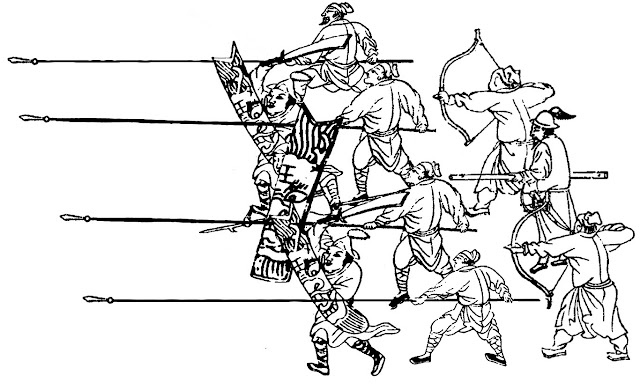 |
| Conjectured image of Luo Gong Chen's shield formation. Image is cropped and doctored from 'Wu Bian Qian Ji (《武編前集》)', 'Ji Xiao Xin Shu (《紀效新書》)' and 'Wu Bei Zhi (《武備志》)'. |
Luo Gong Chen was the magistrate of the Songyang county of Zhejiang. Although not as famous as the legendary Yu Da You (俞大猷) and Qi Ji Guang (戚繼光), Luo Gong Chen was nevertheless a very capable military commander in his own right. He actively participated in the campaign against Wokou (倭寇), and was praised for being "capable of using a lone army to defeat great enemies" by the Ming court due to his exploits. Luo Gong Chen was also a renowned javelin thrower and very knowledgeable in the design and usage of shields. His commentaries about various Ming shield designs were transcribed into many Ming military treatises.
Basic Tactic
Like Mandarin Duck Formation, Luo Gong Chen's formation was very simple and straightforward. It consisted of a ten-man squad led by a squad leader. The squad consisted of three shieldmen armed with either Ai Pai (挨牌), short spears or Gou Lian Qiang (鈎鐮鎗), and sabres, or Yan Wei Pai (燕尾牌) and sabres only, four pikemen armed with long spears, and three shooters armed with either bows, crossbows, or Bian Chong (邊銃). All shieldmen and pikemen were also armed with light javelins. The squad leader was also armed with a long spear with attached military standard.
During battle, the shooters would shoot their missile weapons first to soften up the enemy. As the enemy got closer, shieldmen and pikemen would throw their javelins to disrupt enemy formation, then advance and engage them in close combat. The shooters did not sit idle after they had done their shooting. Instead they followed their comrades and supported them in close combat as well.
Luo Gong Chen's formation was evidently designed for small units that operated independently, since two of the shooters were tasked with guarding the flanks and rear of the formation against enemy ambush if there was no enemy in sight. Nevertheless, this formation could be easily adapted for large scale battle, where it essentially became a large block of pikemen protected by a shield wall at the first rank and supported by missile weapons from the rear ranks.
Comparison with Mandarin Duck Formation
One immediately noticeable difference between Luo Gong Chen's formation and Mandarin Duck Formation was the lack of Lang Xian (狼筅), which was rather unusual as Luo Gong Chen's formation also originated from Zhejiang, the birthplace of this unique weapon. On the other hand, the background of Luo Gong Chen (he was born in Guangxi) and inclusion of Yan Wei Pai into the formation strongly suggest Lang Bing (狼兵) influence.
Lacking protection from Lang Xian, Luo Gong Chen's formation could not prevent enemy troops from closing in as effectively, although it contained enough spears and pikes that charging the formation with shorter weapon was still a very bad idea.
Despite this formation contained more shields, it was actually more offensive oriented than Mandarin Duck Formation, as evidenced by large amount of javelins carried by its close combat troops (indicating that the troops were prepared to charge the enemy once they had thrown their javelins, rather than stand their ground and receive the charge). Luo Gong Chen might have intentionally removed Lang Xian from the formation for this purpose, since even Qi Ji Guang himself commented that Lang Xian usually become more of a liability than asset in a disciplined and determined army.
Other blog posts in my Shield Formation series:
Shield formation of Luo Gong Chen — Part 1
Shield formation of Luo Gong Chen — Part 2
Hi again. Couple of questions;
ReplyDeleteWhat was it that made the Lang Xian a potentially troublesome weapon?
Perhaps this is a wider question than this particular formation, but what's your view on the ability of troops to co-ordinate formations like this? By which I mean it seems to me that that they require a fair degree of training to get troops to work together to use these formations effectively. I have no doubt that if they were trained Ming soldiers were able to, but I wonder whether these drills were suitable for soldiers that were quickly assembled, say in response to coastal raids ?
Good day Clibanarium.
Delete(Although the manual of Lang Xian survived, and reconstructing its techniques should be relatively easy, no one actually test it out in a reenactment-like setting, so I can only answer you based on my own observation, which may or may not contain error)
One of the major issues of this weapon is that poorly trained troops tend to discard it when they are routed, at that point Lang Xian become an obstacle that prevents other friendly troops from escaping.
However, Lang Xian as a weapon is relatively simple to train. As it is a defensive weapon, all you have to do is to point it at the general direction of your enemy, and sweep/smash away their spears or swords if you feel like it. Maybe a thrust or two (it still has a spearhead after all).
For other troops such as pikemen, working together with Lang Xian shouldn't be that hard. In fact, it should be no different from fighting side by side with another pikeman. The branches and leaves of Lang Xian are on the enemy side disrupting them, so they won't obstruct your movement.
Despite its usefulness, Lang Xian is still a defensive weapon, and a bulky one at that. It works fine as long as you stay in an orderly formation and expect your enemy to charge at you. However it become more of a hindrance if you have to aggressively storm an enemy formation or position.
DeleteWould armor have also been worn by these troops?
ReplyDeleteHe did not mention any armour. Or rather, he mentioned the LACK of armour, and something about this formation helps to mitigate the disadvantage of having no armour.
Delete